Cross Country Recumbent
January 2003
This is the story of my bicycle trip across the US. This is
really just my journal of the cross country process, but I hope to do a
good enough job of telling the story that others may want to read
it. However there are no promises; swim at your own risk.
My
name is Bill Vaglienti. I am a 29 year old frisbee-playing
aeronautical engineer who works on autopilots for small unmanned
airplanes. You can read all about me and my company here. For now all you
need to know is that I've been working hard for a few years and I need
a
break.
Genesis of an idea
When I was 18, and newly minted as a
graduate of public high school, a friend and I drove to the Oregon
coast
(from Spokane WA) for a weeks car camping along the Pacific coast.
We spent much of our time on the beach flying kites in the sea
breeze. One day we witnessed a gang of people celebrating a lady
cyclist. All the cheering and video cameras perked our interest
and so we had to ask: it turned out the cyclist was, at that very
moment, beginning her trip across the United States. In typical
teenager eloquence I was only able to come up with: "wow". A
decade would go by before I thought of that moment again.
Years later in my mid-20s I went to see a film festival that was
playing in my local
town. One of the short films
featured a group of friends pedaling across the country. They
were
basketball enthusiasts who were hooping their way from coast to coast,
making new friends the whole way. Their final destination was the
basketball hall of fame. It was a cool film, and by the end my
subconcious was thinking: "maybe one day".
The final straw came one October night playing ultimate with the
regular pick-up group. I had just turned 28, and my life was good
but terribly hectic as (along with my partner, Ross) I was putting in
very long hours trying to make our little venture successful. I
thought to myself "as soons as things settle down I'd like to ride
across the country", sort of a reward for all the hard work. Only
a few moments later I realized how foolish that was. For a small
business owner things never really settle down; I might conceivably
wait
decades before it seemed there was time enough for a venture like that.
I realized that I must have a goal, a personal ultimatum.
Right then I decided that I would ride across the country before I
turned 30. The group playing frisbee that night did not seem as
impressed as I'd hoped they'd be. Oh well. I'd chosen 30
because it is a coming of age time, and because it gave me more than a
year to plan and get my company in shape to do without me for a whole
summer. This meant that sometime in the summer of 2003, before
the
month of October, I'd be making my way across the States.
Choosing a bike
The prospect of riding across the
country was made all the more ambitious because I didn't know a thing
about bicycle touring. I had ridden bicycles all my life, as a
teenager for transportation, and as an adult for fun. The Hood
River area boasts many mountain bike trails, and the bulk of my recent
mileage had been accumulated on a 1997 Gary Fisher Hoo Koo iKoo.
It was painfully obvious that I would need a new bicycle, as well
as training in how to ride long distances. In fact there were
many
questions that needed answering: what route would I take? How
much
stuff would I need to carry? How would I feed myself? Where
would I sleep? What happens if my gear breaks down? Before
I could really answer any of them I would need to begin getting miles
on a road bike, and so I started my research there: choosing a bike.
I went to the local bike shops, looked at the road bikes, lusting after
their beautiful execution of design: the simplicity of a finely honed
machine. But the price tag put me off. Plus it seemed those
bikes were meant more for ego-boosting day trips, not long journeys.
So I put a few feelers out for used road bikes and turned to my
favorite research tool: the internet. Wonder of wonders there are
a whole bunch of people just like me who publish stories and journals
of
riding across the country. I was slightly disappointed at the
evidence of so many people having already done what I expected would be
a uniquely challenging experience; but I was heartened by the fact that
it was obvious it could be done, and you didn't have to be
uber-cyclist,
just patient and willing to perservere. On many of the journals I
found dissatisfaction with the rigors of riding a conventional bicycle
for such a long time. The complaints went from general soreness al the
way up to (yikes!) infections in places I don't want to think about.
Hmm. At this point I thought a little about one of the
folks
I plays frisbee with occasionally, Wes.
Wes is an engineer and cyclist of prodigious talent; and he happens to
ride an electrified BikeE recumbent. His
company makes carbon parts,
including parts for the BikeE; so it was natural for him to use it as
his mode of transportation. When I tried it out I was
underwhelmed; it was reasonbly comfortable, but it felt slow and I
didn't like the handling. However the prospect of severe
saddle-soreness had me thinking more about the recumbent idea. I
began to use the internet to research recumbents exclusively. The
amount of information available is remarkable, just type "
recumbent
bicycle" into
google and
you'll
see what I mean. I learned that although recumbents make up just
a
tiny fraction of the numbers of bikes sold each year, they make up
almost all of the variety: there are short wheelbase (SWB), long
wheelbase (LWB), compact long wheelbase (CLWB), under seat steering
(USS), over seat steering (OSS), direct steering, indirect steering,
front wheel drive (FWD), low racers, high racers, delta trikes, tadpole
trikes, quads, the list never ends.
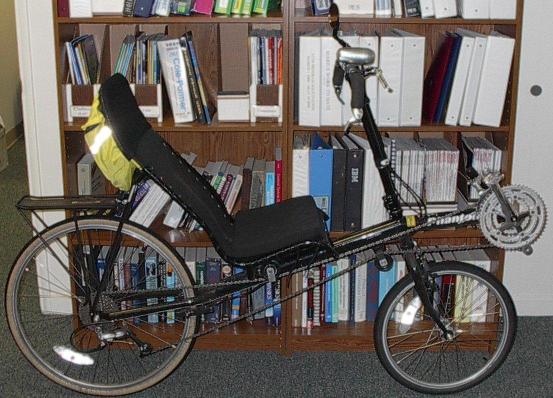
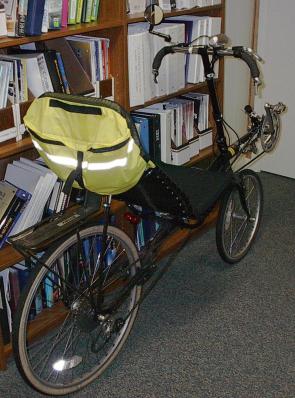
More importantly
from my point of view many of the recumbents I found address my
perceived problems with the BikeE. The recumbent also appealed to
the engineer in me. Whereas a conventional bike (a "
Rover Safety Cycle")
is designed mostly for safety and performance, the recumbent design
adds
rider comfort as one of the fundamental design goals. This
results
in a bike which is heavier but more suited to the long range riding
that
I was planning. Coolest of all is that the recumbent has the
potential to have higher performance owing to the more favorable
aerodynamic position of the rider. There is a rivalry among
cyclists as to which style of human powered vehicle yields the best
performance. It appears to depend mostly on the type of terrain
you ride: recumbents are heavier and suffer from less efficient power
transfer, which makes them weaker on the hills; but the better
aerodynamic posture and more confortable position makes them faster on
the flats, downhills, in headwinds, and on long rides.
No matter the actual or perceived performance differences between
upright bikes (collectively "wedgies") and recumbents ("bents" for
short) the prospect of riding all day without pain was the deciding
factor. After a lot of research, and some test rides on bikes in
Portland, I picked a
Lightning
Phantom as my first recumbent. I chose it based on a compromise
of
price, performance, and comfort. To say that I love the recumbent
would be an understatement. I can barely imagine riding a diamond
frame bicycle now. This last summer (2002) I tried to ride my
old
mountain bike on one of the local favorite trails, Post Canyon. I
was truly shocked at the overall unpleasantness of my body position.
Even though I'd happily ridden that bike for years I could not
now
stomach spending more than a little while on it. For better or
worse I have become, in the parlance of the community, "bent".
Planning the route
With the choice of bicycle out of
the
way I was faced with the next dilema: what roads would I take on my
trip? West to East seemed the best way to go for me. Partly
because I live on the West coast, but mostly because the winds in North
America blow from the West more often than the East. From other
cyclists in town I heard about an organization:
Adventure Cycling. It
turns out these follks are a non-profit that publish bicycling touring
routes, including routes across the US! Faced with the choice of
researching thousands of miles of roads, or just buying a set of maps
from Adventure Cycling, my choice was obvious. The AC folks have
three different cross country routes, the Northern Tier, the
Trans America,
and the Southern Tier. I chose the Trans America since it starts
in Oregon, and goes through Yellowstone. It turns out the Trans
America is the route that started the AC phenomenom. It was
blazed
for the bicentennial of the US, and that year several thousand people
followed it from ocean to ocean. I will start the route with my
wheels ceremoniously dipped in the Pacific ocean in Florence OR, and
then ride better than 4000 miles to finish with wheels in the Atlantic
ocean in Yorktown VA.
June 14 2003
It's been a while since I've worked on this log. The trip hasn't
started yet, so don't go accusing me of slacking! A lot of
planning work has been completed and a lot of miles put on the
bike. The date has been chosen: July 12 2003 is when I'll
start. That's less than a month from now and it's hard to sit
here
writing this without getting all excited about it. The date was
chosen mostly based on the advice of friends of friends who rode part
of
the TA East to West last summer. After their experience they felt
West to East was definitely the way to go, and that I should wait as
long as possible in order to reach the East coast well into the
Fall. In theory this will make crossing the rockies easier (less
risk of bad weather) and allow me to avoid the stifling East coast
heat. Of course I'll just have to face the heat crossing the
plains, but you can't win 'em all.
A lot of folks have been asking me how long it will take. It's
pretty funny to hear their preconceptions: many non-cyclists think I
should be able to whip this trip out in a few weeks. After I
explain the mileage they begin to see the scope of the thing.
I've
been telling people 3 months is my time limit. Based on my
training work I think averaging 50 miles a day should be very do-able,
even including rest days. That means 80 days to go 4000
miles. In fact it'll probably go faster as I work into it, but
the
other advice I keep hearing is: don't rush it! It seems everyone
succombs to a compulsion to put in a lot of miles each day; but when
the
trip is over you'll be sorry you were in a hurry.
Modifications to the bike
I've been working with the phantom
to
try and optimize it for the long riding times. One thing I've
learned is that the further I recline the seat the more I like
it.
Eventually a handlebar modification was required in order to allow me
to
reach the bars with the seat reclined as far as I want. The
solution was a joint which you can see in the first picture. It
works well, but is very heavy and not as solid as the original
one-piece unit that came with the bike. Wes (the same one from
above) offered to help me replace it with a custom carbon setup.
The process is building the part was truly amazing, everything was done
with pre-preg wrapped on a flexible cylindrical mandrel that was then
bent to shape before curing. The picture shows the jig we used to
join the bars with the steer tube. The new unit is lighter and
much stiffer, not to mention sexier. The other thing we had to do
was bend the seat. It seems the lightning folks go for a more
upright posture with a more "closed" riding position. When I laid
the seat back the bottom was cutting into the back of my legs.
Some careful bending (again with Wes's help) allowed us to open up the
seat angle. You can see the difference in comparing the old and
new pictures. The bike really feels "dialed" now.
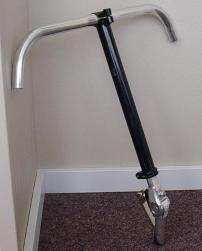
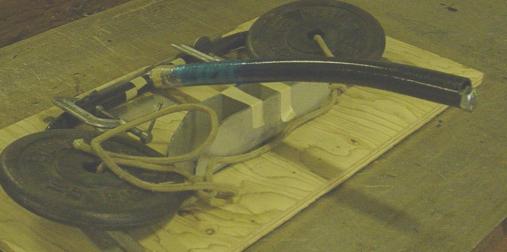
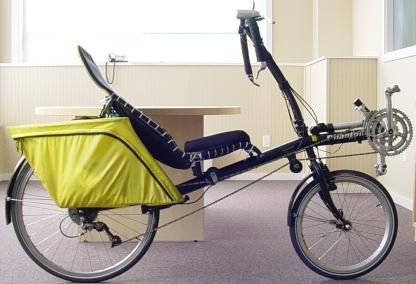
The other thing I've been doing, this time with the help of my good
friend Robert, is to make some bags to hold the gear. It seems
most bike tourists eventually choose between mounting their gear on the
bike in panniers or pulling a trailer like the
bob. Although the trailer
certainly looks convenient I just can't countenance adding yet another
wheel and ten pounds of metal in order to carry the gear. I've
got a set of panniers from lightning that are designed for the
phantom. You can see them in the picture. They work really
well and don't degrade the aerodynamic performance. The panniers
and the rack make a nice deck behind the seat. In the past I've
strapped the big gear here; but the bag works much better because it is
water proof and does a better job of cleaning up the aerodyanics on the
tail end of the bike. The other bag is a long narrow one that
slips behind the seat and straps to it. This one holds two water
bladders for a total of 150 oz of water. Water is key on those
hot
days. During a recent heat wave here, I went riding to see how
the
heat would affect me. The temperature was just under 100F, with
the humidity pretty low. The ride was actually comfortable since
the speed of the bike makes a nice breeze that really helps the
perspiration to evaporate; however I sucked down 160 oz. by the time
I'd
done 50 miles. Hence I think 150 oz. is the minimum amount of
water I should be able to hold since there will certainly be some 50
mile stretches with no water.
For those of you who have gotten this far, you get the reward of my
e-mail address: vaglient@gorge.net

